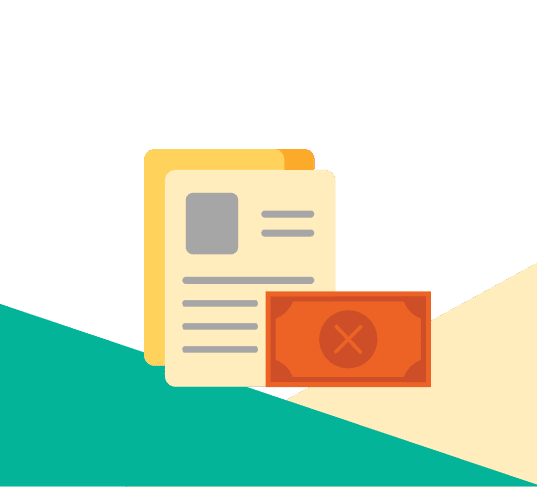Many people with student debt think getting their loans discharged through bankruptcy is difficult or impossible. But that's not necessarily true. Both federal and private student loan bankruptcy discharge might be getting easier to obtain.
If you’re considering declaring bankruptcy and want to discharge student loans, it’s a good idea to consult a lawyer first. But this guide can help you to determine if bankruptcy discharge is a good option for you based on your loan type and overall financial situation.
Can you discharge student loans in bankruptcy?
The short answer is yes. However, unlike other types of debt, student loans have specific legal barriers that make it more difficult for borrowers to discharge their debt through bankruptcy. Private student loans haven’t been dischargeable under standard bankruptcy rules since 2005, and federal loans haven’t been dischargeable under the standard regulations since 1976.
These special rules exist to prevent young borrowers from taking on substantial debt for education, and then wiping their debt clean via bankruptcy. By making student loans harder to discharge, Congress ensured that private lenders would continue providing loans for college education.
But discharging student debt through bankruptcy can be a lengthy process. You typically need to file an additional "adversary proceeding" after your initial bankruptcy filing, and you have to prove that loan repayment would result in undue hardship.
To prove undue hardship, you typically have to show:
- You made a good faith effort to repay your loans prior to the bankruptcy filing.
- You would be unable to repay your loan while still maintaining a reasonable living standard.
- The hardship you're experiencing is likely to persist for a significant portion of your repayment period.
Many people cannot meet these requirements and therefore aren’t able to discharge their student debt through bankruptcy. They have no way to wipe the slate clean and eliminate their debt, other than paying the loans back.
Federal vs. private student loans in bankruptcy
While both federal and private loans can be subject to the undue hardship standard, there are some circumstances where private student loans aren't actually treated in the same way or subject to this difficult standard.
You might get these types of private loans discharged in bankruptcy without meeting the undue hardship standard:
- Loans distributed directly to you where the total amount you borrowed was higher than the school-certified cost of attendance
- Loans that were used to pay for your education at unaccredited colleges, a degree in a foreign country, or other programs not eligible for Title IV funding
- Loans, such as bar study loans, that were issued to pay for living expenses and fees you incurred while studying for professional exams
- Loans made to cover living expenses, fees, or moving costs for residency programs, including medical and dental residencies
- Loans that were issued to you when you were not attending school at least half-time
Any loans that fit these criteria are treated the same as other unsecured debt and are not subject to the added challenge of meeting the undue hardship standard.
Steps to discharge private loans in bankruptcy
If you want to discharge your private loans, filing for bankruptcy is the first step. You’ll need to decide between Chapter 7 bankruptcy and Chapter 13 bankruptcy.
- Chapter 7 bankruptcy is an option if your current monthly income is less than the state median or you can pass a means test. It allows for liquidation of debts.
- Chapter 13 bankruptcy is available without a means test and requires you to pay back some or all debt on a payment plan lasting up to 5 years.
After filing for bankruptcy, you’ll need to file a separate adversary proceeding where you show that student loan repayment would impose an undue hardship.
While courts can impose different processes for determining undue hardship, the Brunner test is the most common. Under this test, you must meet the previously mentioned requirements:
- You can't maintain a minimal standard of living if you're required to repay your loans.
- Circumstances exist that make it likely you will continue to experience financial hardship for a significant portion of the repayment period.
- You made a good faith effort to pay your loans.
Other states use a “totality of circumstances” test, which considers your past, present, and future financial resources, as well as your living expenses and other relevant facts and circumstances in your bankruptcy case.
Important:
If you plan to pursue student loan discharge, make sure to document your efforts to make payments, and be ready to provide proof of income and living expenses.
Discharging student loans may get easier
Although it’s currently challenging to discharge federal and private student loans in bankruptcy, that may be changing.
In 2022, the Department of Justice (DOJ) and the Department of Education introduced new guidance to simplify federal student loan discharge. Borrowers can now fill out an Attestation Form, allowing the DOJ to review and recommend loan discharge.
The form can be found on the DOJ website and asks questions about household members, the loans that are in repayment, and your current income and expenses.
The new guidance simplifies the undue hardship standard by directing the DOJ to use the IRS Collection Financial Standards to determine if loan repayment is possible while maintaining a minimum standard of living. It also assumes a continued inability to pay under specific circumstances, including:
- When the debtor is 65 or older
- If the debtor didn’t obtain a degree after borrowing
- In cases where the debtor has been unemployed for at least the past 5 years
- When the debtor has a disability or chronic injury that affects their earning potential
Several courts have also ruled in recent years that private student loans can be discharged in bankruptcy. This could potentially serve as precedent for private student loan forgiveness in the future, if other courts adopt the same reasoning.
Alternatives to bankruptcy for private student loan relief
While bankruptcy may become more widely available for student loan discharge, that doesn't mean it's always the right option.
Claiming bankruptcy can damage your credit and have long-term financial consequences. Before filing, you may want to consider other options, including the following:
- Refinancing student loans: If you have private student loans, you can refinance with another private loan lender without giving up any borrower benefits. You may be able to reduce your monthly payments and make them more affordable.
- Putting loans into deferment or forbearance: Both private lenders and the Department of Education offer these options to pause payments temporarily. However, not all private lenders offer these options, so check with yours to find out if this is a possibility.
- Negotiating with private lenders: Many private student lenders may negotiate to help you reduce your payment or to make a lump-sum payment rather than filing for bankruptcy.
- Changing repayment plans: You can change payment plans with federal student loans, and many income-driven plans can result in low monthly payments (sometimes as low as $0). Check with your private loan lender to find out if it offers various repayment plan options.
It’s important to get help if you’re worried about making student loan payments. You may be able to find an alternative to bankruptcy. If you don’t think you can pay back what you owe under any circumstances, speaking with a bankruptcy lawyer about student loan discharge could help you to determine if this is an option for you.
Credible rating
Fixed (APR)
5.48% -
Loan Amounts
$10,000 up to total refinance amount
Min. Credit Score
680
Credible rating
Fixed (APR)
5.49% -
Loan Amounts
$5,000 - $250,000
Min. Credit Score
680
Credible rating
Fixed (APR)
5.85% -
Loan Amounts
$5,000 - $250,000
Min. Credit Score
670
Credible rating
Fixed (APR)
6.00% -
Loan Amounts
$7,500 - $200,000
Min. Credit Score
700
Credible rating
Fixed (APR)
6.20% -
Loan Amounts
$10,000 up to the total amount
Min. Credit Score
670
Credible rating
Fixed (APR)
6.34% -
Loan Amounts
$7,500 - $250,000
Min. Credit Score
680
Credible rating
Fixed (APR)
6.49% -
Loan Amounts
$10,000 - $750,000
Min. Credit Score
Does not disclose
All APRs reflect autopay and loyalty discounts where available | LightStream disclosure | SoFi Disclosures | Read more about Rates and Terms


